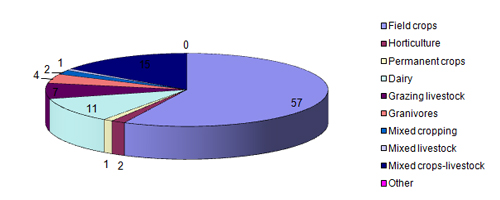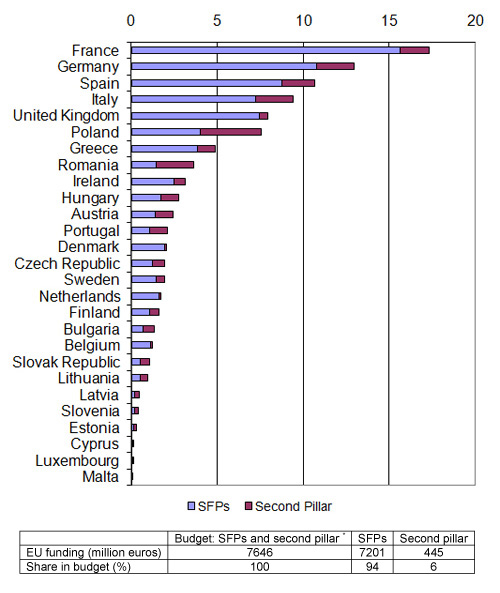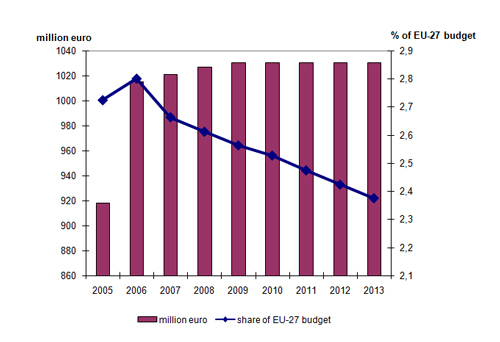Denmark
• General country description
• A. First pillar: implementation of CAP reforms (2003)
• B. Second pillar: implementation of RDP measures during 2007-2013
• C. Vision for the CAP beyond 2013: a short overview of the debate (at Member State level) on future CAP reform
• D. Literature, sources, references
• The comparative analysis provides a compact overview of CAP implementation across all 27 Member States and their visions of the future of the CAP
General country discription
Denmark |
Comparison with EU-25 |
Population, 2005 (*1,000,000): 5.4 |
1.2% of population in EU-25 |
Population density, 2003 (inh./km2): 125 |
118 in EU-25 |
GDP/capita, 2005 (PPS): 28,900 |
124% of GDP/capita in EU-25 |
Share agriculture in total employment, 2002 (%): 4 |
5% in EU-25 |
Share Utilized Agricultural Area in total land area, 2003 (%): 62 |
46% in EU-25 in 1998 |
Average farm size, 2005 (ha): 54 |
19 in EU-15 |
Number of farms, 2005 (*1000): 48.1 |
0.7% of farms in EU-25 |
Source: own calculations based on Eurostat
Distribution of farming types, 2005 (% of total)

Source: own calculations based on Eurostat
EU funding for the Single Payment Scheme (SPS)
and the second pillar, 2007-2013

Funding according to CAP budget including Bulgaria and Romania.
Sources: Agra Europe (2007); CEU (2006); EC (2007a)
A. First pillar: implementation CAP reform (2003)
A.1 Single Payment Scheme
Model
SPS dynamic hybrid moving towards flatter rates (one region) (EC, 2007b)
Coupling measures
Complete decoupling, except for special male bovine premium (75% coupled), sheep and goat premium (50% coupled)
Reason for selection
- no reallocation of historical distribution of payments in order to prevent income effects;
- partly coupling in order to maintain certain types of production.
A.2 EU budget for Single Payment Scheme (SPS) per year (National ceiling) 2005-2013

Source: 2005: EC (2006); 2006-2013: CEU (2006) and Agra Europe (2007)
Share of the farms that receive SPS of the total number of farms (% of total)
estimate 99,99%*
Tradability of SPS
Yes - payment entitlements are tradable within the Member State (Denmark is one region)
A.3 Cross-compliance: Good Agricultural and Environmental Conditions (GAEC)
Source: IEEP, 2005
Selected standards of the GAEC
Issue |
Standards |
Summary of farmers’ obligations |
Soil erosion |
Minimum soil cover |
within two weeks after harvest and no later than 1 oct, except if harvest is later then 1 oct; plant cover by seeds approved by Danish Plant Directorate; beetle banks and enhancement wild life possible. |
|
minimum land management reflecting site-specific conditions |
set-aside areas and agricultural areas maintained by cutting at least every second year |
protection of permanent pastures |
|
rules depend on degree of decrease (5 or 10%); cutting in July or August at least every second year; alternative is grazing if area difficult to access |
minimum level of maintenance |
avoiding the encroachment of unwanted vegetation on agricultural land |
keep plant cover intact |
|
EXTRA: set-aside management |
maintain by cutting in July or August at least every two years; no cutting between 1-5 and 30-6 |
|
EXTRA: agricultural land no longer in use |
maintain by cutting in July or August at least every two years; no cutting between 1-5 and 30-6; no use of pesticides |
Denmark focuses on minimum land management by keeping minimum level of maintenance; national legislation implemented to support permanent pastures; underlying idea is protection of water environment.
Reason for selection of cross compliance standards
Especially protection of water environment.
A.4 Further reform of market regulations
No information.
* Estimate by Paul Hoffman, Danish Ministry Ministry of Food, Agriculture and Fisheries
B. Second pillar: implementation of RDP measures 2007-2013
B.1 Programme level and approval
There is one national RDP for Denmark. The Rural Development Committee (consisting of representatives of the 27 Member States) has approved the RDP for Denmark on 24 January 2008.
B.2 Distribution of public budget over the axes (%) 1)
axis 1: competitiveness |
axis 2: environment and land management |
axis 3: rural economy |
Axis 4: Leader |
21 |
64 |
5 |
10 |
Figures excluding Technical Assistance
Source: Own calculations based on Ministeriet for Fødevarer, Landbrug og Fiskeri (2007)
B.3 Integration of Leader in axes 1, 2 and 3
Leader (Axis 4) only contributes to axis 3, but is expected to cover two third of the budget in axis 3.* In addition, Leader should contribute to the improvement of new approaches to governance and to the mobilization of the endogenous development of local sources and actors.
B.4 Local Action Groups (LAGs)
There is an intention to create approximately 50 LAGs covering up to 63 municipalities (compared to 12 LAGs in the previous period).**
B.5 RDP budget 2007-2013 (million euros)
total public budget |
% co-financing EAFRD1) |
EAFRD budget |
Contribution private sector |
Total costs |
National top-ups |
830.8 |
54 |
444.7 |
355.5 |
1186.3 |
0 |
1) % of co-financing may vary per axis
Source: Ministeriet for Fødevarer, Landbrug og Fiskeri (2007)
B.6 Less Favoured Areas
In 2005 30,000 ha was designed as Less Favoured Areas (LFA) (1.1% of UAA). These are areas with specific restrictions (CEU, 2005).
B.7 Drivers of RDP strategy***
Fit within national policy (please specify national policy documents)
- Strategy for Denmark in the global economy, 2006;
- Multi-annual plan for sustainable and environmentally friendly livestock production, 2006;
- National Aquatic Environment Plan III 2005-2015;
- National Pesticide Plan 2004-2009;
• National Action Plan for biological diversity and environmental protection in Denmark 2004-2009;
• National Forestry Program 2002.
Try to implement EU rural development priorities as an addition to the national policy
- Conclusions from the meetings of the European Council in Lisbon and Gothenburg;
- Natura 2000 Directives and the Water Framework Directive;
- EU's 2010 objectives for arresting the decline in biodiversity.
Other
- Kyoto protocol.
* Information provided by Poul Hoffman, Ministry of Food, Agriculture and Fisheries of Denmark, Copenhagen.
** Ibid
*** Ibid
C. Vision on the CAP beyond 2013
C.1 Stages in the development of the CAP debate
Is there a debate about the CAP beyond 2013? *
There is much public debate among relevant ministries, farmers organizations, consumers organizations and NGOs. In addition, citizens are also involved in the debate. As a means to conclude the national reflection period on the future of Europe, in 2006 Danish citizens were asked to identify the main tasks and problems of Europe. Three main concerns were put forward: (1) the procedures of the EU are too complicated; (2) control of the EU's money is too poor; and (3) the CAP is not sufficiently reformed.
C. 2 Key issues in the debate **
Components and role of the CAP
- The direction set out in the CAP 2003 reform must be maintained and strengthened;
- The CAP must continue to be the cornerstone for European Agriculture in order to ensure equal conditions of competition in a well functioning internal market and to ensure growth, innovation and development in all rural areas of Europe in agreement with the Lisbon Strategy;
- There is a need for further liberalisation and market orientation of the CAP combined with increased emphasis on growth and development;
- Long term changes of the CAP should be in line with the aim of enabling the European Model of Agriculture to develop in consistency with consumer and market demands;
- Full decoupling of direct payments
- Abolishing of export subsidies, quotas, market support measures and intervention;
- Worldwide, there is a need for a global agreement on trade to ensure equal conditions of competition on the international market and to ensure a further improvement of global trade. Agricultural support should therefore be targeted and compatible with the WTO green box.
Organization of the CAP (1st and 2nd pillar)
- Strive for simplification: the day-to-day administration of the CAP imposes heavy burdens on the farmers and on the national administrations. Serious efforts must be made to cut red tape and reduce the volume and complexity of CAP legislation, not only as regards the mere technical aspects but also as regards the policies.
Financing of the CAP
- Renationalization must be avoided;
- In the long run there is a need to substantially reduce total agricultural support in the EU (both EU budget and national budgets);
- Although State aid should be limited as much as possible, this should not result in jeopardising the objectives of the rural development policy;
- Continuation of the transfer of CAP funding from Pillar 1 to Pillar 2.
* Information provided by Lars Bo Larsen, Embassy of Denmark in The Hague.
** Derived from the note 'The European Model of Agriculture - Challenges Ahead; Danish views'.
D. Literature, sources, references
- Agra Europe (2007), "Threat of SFP cuts rises as NMS accede", Agra Europe Weekly, January 12
- Council of the European Union (CEU) (2005), Proposal for a Council Regulation on support for rural development by the European Agricultural Fund for Rural Development (EAFRD) - redefinition of intermediate less-favoured areas, Brussels, Working Party on Agricultural Structures and Rural Development, working document (7971/05), 15 April
- Council of the European Union (CEU) (2006), Council Regulation 1782/2003 (consolidated version - August 5, 2006), Annex VIII and VIIIa, Brussels
- European Commission (EC) (2006), 35th Financial Report on the European Agricultural Guidance and Guarantee Fund, Guarantee section, 2005 Financial Year, SEC(2006)1152
- European Commission (EC) (2007a), EU support for rural development 2007-2013; Pre-allocated funding under Heading 2 "Natural Resources" of the Financial Framework, Brussels: European Commission
- European Commission (EC) (2007b), Overview of the implementation of direct payments under the CAP in Member States Version November 2007, EC, DG for Agriculture and Rural Development
- IEEP (2005), The development and implementation of cross compliance in the EU15: an analysis. Report for the RSPB, Institute for European Environmental Policy
- Ministeriet for Fødevarer, Landbrug og Fiskeri (2007), Det danske landdistriktsprogram 2007-2013, version 8 May 2007
